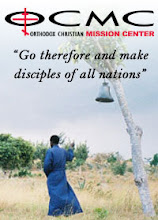In 2010, I visited Albania in order to meet with Archbishop Anastasios in the capital of Tirana, and to visit the Holy Resurrection Seminary in Durres. I had the privilege to travel in conjunction with a Missions class from Holy Cross and St. Vladimir's Seminaries taught by Fr. Luke Veronis, a former OCMC Missionary in Albania and author of the recent book, Go Forth: Stories of Mission and Resurrection in Albania.
Albania is along the eastern coast of the Adriatic Sea, north of Greece. Albania became an independent country in 1912, following the breakup of the Ottoman Empire. After World War II, Albania fell under communist rule until 1992. In 1967, the communist government outlawed religion, destroying or confiscating all religious buildings, and attempting to eliminate the Christian faith.
Prior to its conquest by the Turks, Albania was part of the Roman Empire. During this period, Albania’s port of Durres was an important link between Italy and the Roman road to Thessalonica and Constantinople. Christianity is thought to have come to Albania with the visit of St. Paul to Durres in the first century. By the end of the first century the Church in Durres had grown and had its own bishop, Asti, who was martyred under the Emperor Trajan.
Durres today contains extensive Roman ruins including a large amphitheater. I had the opportunity to visit this amphitheater with Nathan Hoppe, an OCMC Missionary in Albania, and to see the remains of two early Christian chapels built in its passageways to commemorate Christians who were martyred there.
I was also able to visit a site associated with another early Christian martyrdom when I visited Holy Resurrection Seminary built on a hill, overlooking Durres. The hill was the site of the Monastery of St. Vlash (Blaise). Tradition ascribes his martyrdom to this spot in the fourth century, which suggests that he is a different person than the well known St. Blaise of Sebaste, martyred in Armenia. The Church was an important pilgrimage site known for miraculous healings, and perhaps for this reason was the first church destroyed at the beginning of the anti-religious campaign of 1967. The church was rebuilt following the fall of communism in 1992, and the hill is now also the location of the Holy Resurrection Seminary and the Home of Hope for children. During my visit to the Seminary, I was able to meet with Bishop Nikola and some of the seminarians, and also to attend a large youth retreat held at the Seminary.
The Christian faith spread in Albania, as in the rest of the Roman world, following the end of the Roman persecutions in the fourth century. Unfortunately, much of the material heritage of Christianity in Albania was damaged or destroyed during the communist period, when approximately sixteen hundred Orthodox churches were destroyed. However, since the end of communism, the Orthodox Church in Albania, with the help of others, has rebuilt and repaired many of these damaged and destroyed buildings.
In contrast to historic Durres on the coastal plain, Tirana, the capital, is a more recent and much larger city surrounded by mountains. Here, I was able to visit an important exhibit of Albanian Christian manuscripts. These manuscripts had been confiscated by the communist government and were now being displayed to the Albanian public for the first time. Two of the manuscripts were Gospels from the sixth century. Their existence testifies to the tenacity of the Christian witness in Albania despite the many invasions that disrupted life in the Balkans through the Middle Ages and the Turkish conquest of the fifteenth century.
Unfortunately, many Christians abandoned their faith during the approximately four hundred years of Turkish rule. As a result, by the time of the communist takeover, only twenty percent of Albanians were still members of the Orthodox Church. Following this, the years of communist persecution largely reduced Albania to a secular country. However, following the end of communism in 1992, church life has been revived under the leadership of Archbishop Anastasios. He is a leading proponent of Orthodox missions, who, after serving in East Africa, has overseen the enormous work of rebuilding the Church in Albania after the fall of communism.
While in Tirana, I also met a number of the clergy and church workers, and had a chance to speak briefly about St. Herman of Alaska to the Orthodox Sisterhood. The two functioning Orthodox churches in Tirana were restored to the Church by the government. A new, larger, cathedral is now being built to replace the one that was destroyed.
Albania has a long heritage of Christian faith, but due to historical circumstances the majority of the country has been deprived of the knowledge of Christ for many years. However, now, by God’s mercy, the end of communism and the rebuilding of the Church in Albania have created an opportunity for the spread of the gospel. It was good to see how energetically this work has been begun, and we look forward to the possibility of being able to assist the Church there in its further growth.
Subscribe to:
Post Comments (Atom)


No comments:
Post a Comment